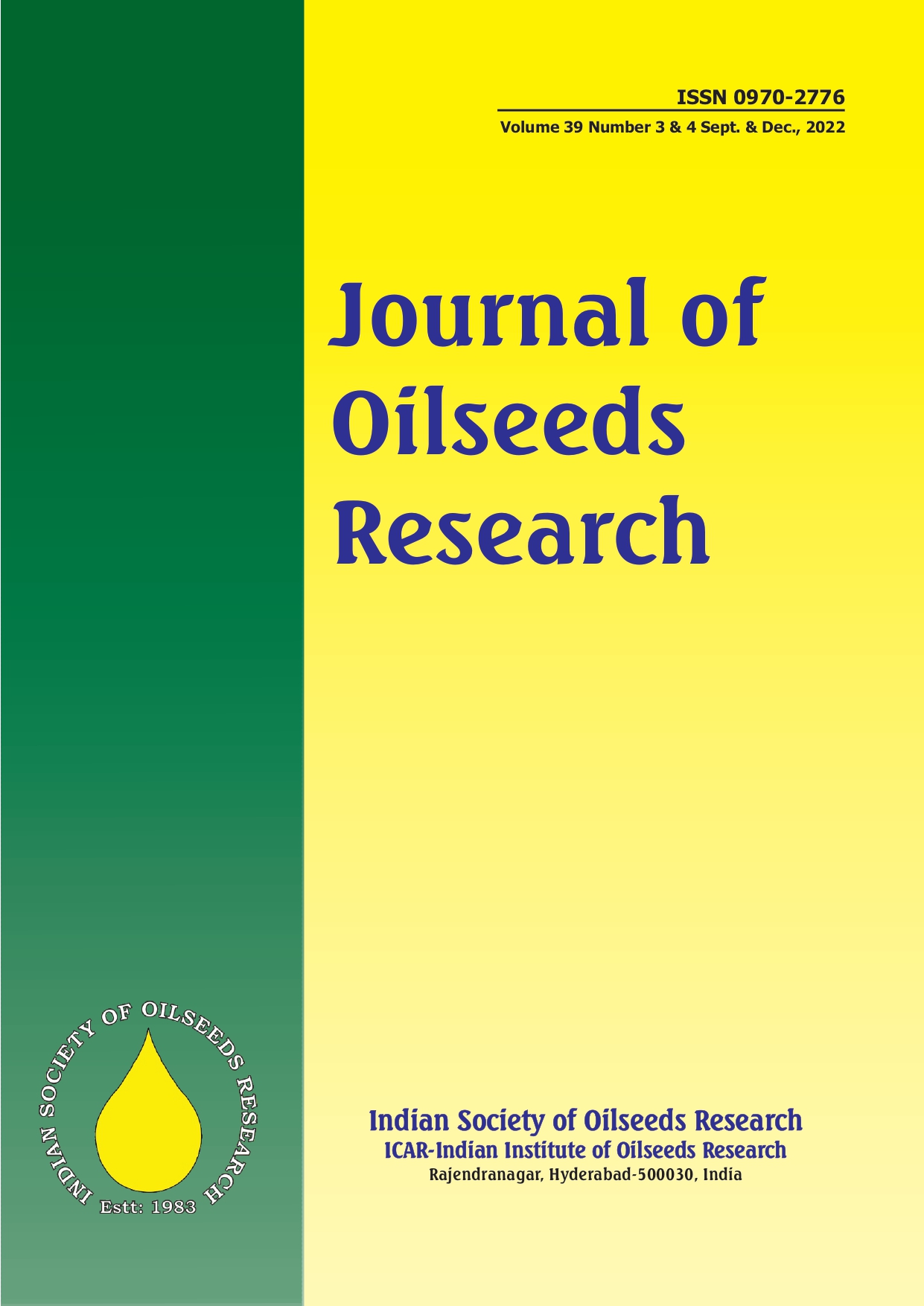Genetic variability studies of major yield components in segregating population derived from pistillate lines of castor (Ricinus communis L.)
GENETIC VARIABILITY OF YIELD COMPONENTS IN SEGREGATING POPULATION LINES OF CASTOR
127 / 2
Keywords:
Castor, Frequency distribution, Heritability, Phenotypic and genotypic coefficient of varianceAbstract
A segregating population was developed by crossing two pistillate (female) lines of castor viz., IPC-23 and IPC-21. Population behavior was studied to understand the variability for major yield and yield components. The distribution of node number, plant height and seed yield were deviated fromnormal distribution and it was positively skewed with significant leptokurtic curve indicating that the two parents with high seed yield were selected for population development. Positive skewness indicates that the plants with exceptionallyhigh seed yield were isolated from the population. Difference between phenotypic co-efficient of variation (PCV) and genotypic co-efficient of variation (GCV) was very low to moderate for major yield components viz., number of effective spikes per plant, number of nodes to primary spike, plant height, total spike length and effective spike length of primary indicating that phenotypic selection can be effectively used for yield improvement. High heritability and genetic advance over mean (GAM) indicated the role of additive gene action for plant height and total/effective primary spike length. Correlation of number of nodes up to the primary spike with plant height up to primary spike, and total/effective spike length was positive indicating the possibility of short-statured, early pistillate selections with long primary spikes in castor.
Downloads
References
Alemaw G, Kassahun B M, Taye G and Endalamaw C 2014. Phenotypic variability in Ethiopian castor (Ricinus communis L.) accessions. International Journal of Advanced Biological and Biomedical Research, 2(12): 2909-2914.
Chaudhari D R, Parmar V L, Dube D V, Bhakta R S, Patel A I and Lodam V A. 2016. Genetic variability and divergence study in castor (Ricinus communis L.). Advancements in Life Sciences, 5(16): 6418-6422.
Dapke J S, Naik M R, Vaidya G B, Vanve P B, Narwade AV and Rajkumar B K 2016. Genetic variability in castor (Ricinus communis L.). European Journal of Biotechnology and Bioscience. 4(4): 39-40.
Golakia P R, Kavani R H and Monpara B A 2007. Genetic variation and trait relationship in castor. National Journal of Plant Improvement, 9(1): 60-62.
Jignesh H K, Mital D J, Ajay B C, Bera S K and John J G 2020. Effect of selection response for yield related traits in early and later generations of groundnut (Arachis hypogaea L.). Crop Breeding and Applied Biotechnology, 20 (2). https://doi.org/ 10.1590/1984-70332020v20n2a31.
Johnson H W, Robinson H F and Comstock R E 1955. Estimates of genetic and environmental variability in soybean. Agronomy Journal, 47: 314-318.
Lakshmamma P, Lakshmi P, Mohan Y C and Lavanya C 2005. Genetic variability and character association in castor (Ricinus communis L.). National Journal of Plant Improvement, 7(2), 122-130.
Lavanya C and Solanki 2010. Crop improvement of castor: The challenges ahead. In: Hegde D.M., (Ed) Research and development in castor: present status and future strategies. Ind. Soc. Oilseeds Res. Hyderabad. pp 36-55.
Lavanya C, Ushakiran B, Sarada C, Manjunatha T, Senthilvel S, Ramya K T and Santhalakshmi Prasad M 2021. Use of single seed descent versus pedigree selection for development of elite parental lines in castor (Ricinus communis L.). Genetic Resources and Crop Evolution, 68: 295-305.
Mehta D R and Vashi P S 1997. Variability, heritability and genetic advance in castor. Agricultural Science Digest, 17: 236.
Patel J K, Saiyed M P, Patel C G, Bhatt R K and Bhatt J P 2010. Genetic variability and correlation studies in castor (Ricinus communis L.). International Journal of Agricultural Science, 6(1): 129-131.
Patel P S and Jaimini S N 1991. Interrelationship and path analysis of certain quantitative characters in castor. Journal of Oilseeds Research, 8: 105-109.
Ramesh, Rakesh Choudhary, Mamta Nehra and Manish Kumar 2021. Combining ability analysis of newly developed male lines of castor (Ricinus communis L.) in Rajasthan. Journal of Oilseeds Research, 38(4): 337-342.
Salihu B Z, Falusi A O, Gana A S, Adebola M O and Daudu O Y 2017. Estimation of heritability and predicted genotype mean for seed yield of castor (Ricinus communis L.) using Best Linear Unbiased Prediction (BLUP). Journal of Plant Development, 24: 51-65.
Senthilvel S, Manjunatha T and Lavanya C 2022. Castor breeding. In: Yadav D K, Dikshit H K, Mishra G P and Tripathi S. (Eds). Fundamentals of Field Crop Breeding. Springer Singapore, ISBN 978-981-16-9256-7.
Sivasubramanian S and Madhavamenon P 1973. Genotypic and phenotypic variability in rice. Madras Agricultural Journal, 60(8-9): 1093-1096.
Suresh G, Lavanya C, Duraimurugan P, Santhalakshmi M P, Manjunatha T, Lakshmi P, Jawahar J L and Reddy A V V 2020. Castor: Production Technology. 7 th Revised Edition. ICAR-Indian Institute of Oilseeds Research, Hyderabad. pp.26.
Verma J P 2012. Data analysis in management with SPSS software. Springer Science & Business Media.
Weber C R and Moorthy B R1952. Heritable and non-heritable relationships and variability of oil content and agronomic characters in the F2 generation of soybean crosses. Agronomy Journal, 44: 202-209.
